Neoplan
VIP Class |
|
| Type | Private company with limited liability - GmbH, subsidy of MAN Nutzfahrzeuge AG[1] |
|---|---|
| Industry | Automotive |
| Founded | 1 July 1935[2][3] |
| Founder(s) | Gottlob Auwärter[2] |
| Headquarters | Stuttgart, Germany[2] |
| Number of locations | Plauen, Saxony, Germany[2] |
| Key people | Joachim Reinmuth, Chairman of the Board of Management former designers: Albrecht Auwärter, Bob Lee, Konrad Auwärter |
| Products | Buses[4] Coaches[4] Trolleybuses[4] |
| Employees | 1,300 |
| Parent | MAN SE |
| Website | NEOPLAN.de |
NEOPLAN Bus GmbH is a German automotive industry company which manufactures buses, trolleybuses and coaches. NEOPLAN is now a subsidiary of NEOMAN Bus GmbH, which itself is a part of MAN SE. The company is known for its innovative futuristic designs and technical expertise.
Contents |
History
Foundations
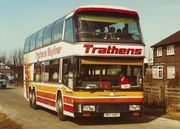
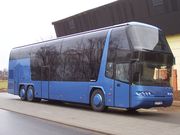
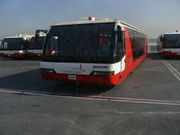
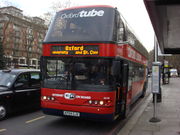
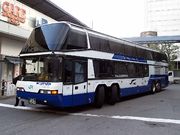
The company was founded by Gottlob Auwärter in Stuttgart in 1935,[2][3] and manufactured bodywork for bus and truck chassis.[3] From the beginning, the design of the buses produced was stylistic. After World War II, an all-steel body design was developed, a rarity at that time.[3] The company became known for its technical expertise,[5] and by 1953 had moved away from manufacturing buses on truck chassis,[3] to a partial monocoque design with a steel tube skeleton, providing the structural support,[3][5] enhanced by welded side panels.[3] The engine was moved to the rear,[3] and the running gear and body functioned as one. In 1957, air suspension[5] was made available, greatly improving the ride of the bus for the passenger.
1960s
In 1961, a new design, the Hamburg,[6] was unveiled at the Geneva Salon and caused a sensation in the industry. At a time when most coaches were rounded, bulbous or streamlined, the new design had clear-cut lines with edges and large windows.[6] Developed by the founder's eldest son Albrecht Auwärter and another student, Swiss Bob Lee, as part of their dissertation at Hamburg University, the design also allowed every passenger to regulate fresh air supply through a nozzle from two air ducts.[6]
Both Albrecht and Lee joined NEOPLAN after university. Albrecht took over management of the company in 1965. Bob Lee became head of Engineering and Design.
In 1964, the founder's second son, Konrad Auwärter, developed a double-deck design for a service bus as part of his dissertation.[6] The 'Do-Bus' design had extremely low weight, and could carry over 100 passengers.[6] It also featured a low-frame front axle with forward-mounted steering gear that permitted a low flat floor.[5][6] The double-deck principle was applied to coach design, creating a revolutionary high-capacity comfortable vehicle for touring. This vehicle was known as the Skyliner,[7] and created an image for the company that differentiated the NEOPLAN brand from its competitors, and created interest in its products across Europe.
1970s
In 1971, the Cityliner was introduced.[7] This design had a passenger platform at a level above the driver's cab, and included an onboard toilet.[7] The vehicle also made use, for the first time, of glass-fibre reinforced plastic for certain areas of the body.[7] In 1973, the Jetliner was introduced,[8] featuring a large one-piece windscreen, with the driver and door windows sloping from the passenger window line down to the bottom of the windscreen level.[8]
A second manufacturing facility opened in Pilsting in 1973,[2][8] and a third opening in Kumasi, Ghana in December 1974[2] to support a large order.[8]
The double-deck Skyliner concept was taken to its ultimate conclusion in 1975, with the introduction of the Jumbocruiser,[8] a double-deck articulated coach 18 metres (59 ft 1 in) long[5][8] and 4 metres (13 ft 1 in) high.[8] The Spaceliner,[9] introduced in 1979 took the Cityliner concept of passenger floor level above the driver, and extended the actual floor above the cab. This kept the height of the vehicle lower than a double-decker, at 3.65 metres (12 ft), but still allowed installation of toilets, kitchens or sleep cabins below the passenger compartment.[9]
1980s
A new fourth plant was added in 1981 in Berlin,[9] and Bob Lee led the establishment of a fifth plant in Lamar, Colorado. In 1984, a further plant was added in Honey Brook, Pennsylvania. The US plants were later spun off into a separate, and now defunct, independent company (Neoplan USA) that used the NEOPLAN name under license.
In 1980, the United Kingdom deregulated services over 35 miles (56 km) in length. This led to intense competition on a variety of long-distance services, with operators looking to differentiate their service. NEOPLAN vehicles, with their futuristic design and high quality construction, began to be imported in greater numbers. These vehicles, so different from the products of the UK coachbuilders Duple and Plaxton, became increasingly popular. In particular the Skyliner, with its head-turning design, comfort, and high capacity, became a status symbol for many operators of the period, in particular, Trathens Travel Services of Plymouth.
The Metroliner was introduced in 1988.[10] This vehicle was the first full monocoque bus in the world, requiring no separate chassis or skeleton.[10]
1990s
A manufacturing facility was opened in Ehrenhain in 1990.[10]
In 1992, the 15 metres (49 ft 3 in) four-axle Megaliner was introduced,[11] prompting a change in European Union regulations to allow non-articulated vehicles greater than 12 metres (39 ft 4 in) in length. The Starliner was introduced in 1996,[11] and would go on to win the Bus of the Year award for two consecutive years - in 1998 and 1999.[12]
2000s
In 2001, NEOPLAN, or correctly, "Gottlob Auwärter GmbH & Co KG" was acquired by MAN AG subsidy MAN Nutzfahrzeuge AG[13] to form NEOMAN Bus GmbH. The Starliner wins the Bus of the Year award for two more years in 2001 and 2002.[13]
A new coach designed for touring was introduced in 2003 under the name Tourliner,[14] and the Starliner was redesigned in 2004, representing arguably the most futuristic vehicle yet to bear the NEOPLAN name, and included technical advancements such as Electronic Stability Programme (ESP).[14]
The Trendliner was released in 2004,[14] as a 'dual purpose' intercity and combination bus - which is designed to be used seven days a week.[14]
In 2005, two new shorter 13 metres (42 ft 8 in) versions of the Tourliner and Trendliner were released.[15] From 2006, Euro4 compliant engines from MAN began being fitted in the new generation Cityliner.[15]
In 2007, a new Auwärter Museum was opened in Landau/Isar.[15]
On 1 February 2008, NEOMAN Bus GmbH was fully integrated into the Bus Division of the larger MAN Nutzfahrzeuge Group, and ceased to exist in its own right. NEOPLAN and MAN AG Buses now operate as two separate but integrated marques of MAN Nutzfahrzeuge Group.[16] As a result of the reorganisation and restructuring of the Bus Division, NEOPLAN will concentrate on production at its Plauen and Pilsting sites, with Plauen being used for premium luxury coaches, whilst Pilsting will concentrate on customisations.[17]
Products
Current
Coaches
| model | internal combustion engine [18][19] |
max. power @ rpm [18][19] |
max. torque @ rpm [18][19] |
transmission | wheelbase | length | width | height |
|---|---|---|---|---|---|---|---|---|
| Tourliner [20] |
MAN D2066 LOH 03 or 04, 10,518 cc (641.8 cu in) R6 common rail turbodiesel MAN D2676 LOH EEV, 12,419 cc (757.9 cu in) R6 common rail turbodiesel |
294 or 324 kW (400 or 441 PS; 394 or 434 hp) @ 1,900 324 kW (441 PS; 434 hp) @ 1,900 |
1,900 or 2,100 N·m (1,401 or 1,549 ft·lbf) @ 1,000-1,400 2,100 N·m (1,549 ft·lbf) @ 1,100-1,400 |
6-speed manual or 12-speed TipMatic ZF AS Tronic automated manual |
6,060 mm (238.6 in) | 12.00 m (39 ft 4 in) | 2.55 m (8 ft 4 in) | 3.80 m (12 ft 6 in) |
| Tourliner C (multi-axle) [20] |
MAN D2676 LOH EEV, 12,419 cc (757.9 cu in) R6 common rail turbodiesel MAN D2066 LOH 04, 10,518 cc (641.8 cu in) R6 common rail turbodiesel |
324 or 353 kW (441 or 480 PS; 434 or 473 hp) @ 1,900 324 kW (441 PS; 434 hp) @ 1,900 |
2,100 or 2,300 N·m (1,549 or 1,696 ft·lbf) @ 1,100-1,400 2,100 N·m (1,549 ft·lbf) @ 1,000-1,400 |
6-speed manual or 12-speed TipMatic ZF AS Tronic automated manual |
6,060 and 1,470 mm (238.6 and 57.9 in) | 13.26 m (43 ft 6 in) | 2.55 m (8 ft 4 in) | 3.80 m (12 ft 6 in) |
| Tourliner L (multi-axle) [20] |
MAN D2676 LOH EEV, 12,419 cc (757.9 cu in) R6 common rail turbodiesel MAN D2066 LOH 04, 10,518 cc (641.8 cu in) R6 common rail turbodiesel |
324 or 353 kW (441 or 480 PS; 434 or 473 hp) @ 1,900 324 kW (441 PS; 434 hp) @ 1,900 |
2,100 or 2,300 N·m (1,549 or 1,696 ft·lbf) @ 1,100-1,400 2,100 N·m (1,549 ft·lbf) @ 1,000-1,400 |
6-speed manual or 12-speed TipMatic ZF AS Tronic automated manual |
6,600 and 1,470 mm (259.8 and 57.9 in) | 13.80 m (45 ft 3 in) | 2.55 m (8 ft 4 in) | 3.80 m (12 ft 6 in) |
| Cityliner [21] |
MAN D2066 LOH 03 or 04, 10,518 cc (641.8 cu in) R6 common rail turbodiesel MAN D2676 LOH, 12,419 cc (757.9 cu in) R6 common rail turbodiesel |
294 or 324 kW (400 or 441 PS; 394 or 434 hp) @ 1,900 324 kW (441 PS; 434 hp) @ 1,900 |
1,900 or 2,100 N·m (1,401 or 1,549 ft·lbf) @ 1,000-1,400 2,300 N·m (1,696 ft·lbf) @ 1,100-1,400 |
6-speed manual or 12-speed TipMatic ZF AS Tronic automated manual |
6,060 mm (238.6 in) | 12.24 m (40 ft 2 in) | 2.55 m (8 ft 4 in) | 3.68 m (12 ft 1 in) |
| Cityliner C (multi-axle) [21] |
MAN D2066 LOH 04, 10,518 cc (641.8 cu in) R6 common rail turbodiesel MAN D2676 LOH, 12,419 cc (757.9 cu in) R6 common rail turbodiesel |
324 kW (441 PS; 434 hp) @ 1,900 324 or 353 kW (441 or 480 PS; 434 or 473 hp) @ 1,900 |
2,100 N·m (1,549 ft·lbf) @ 1,000-1,400 2,100 or 2,300 N·m (1,549 or 1,696 ft·lbf) @ 1,100-1,400 |
6-speed manual or 12-speed TipMatic ZF AS Tronic automated manual |
6,200 and 1,470 mm (244.1 and 57.9 in) | 12.99 m (42 ft 7 in) | 2.55 m (8 ft 4 in) | 3.72 m (12 ft 2 in) |
| Cityliner L (multi-axle) [21] |
MAN D2066 LOH 04, 10,518 cc (641.8 cu in) R6 common rail turbodiesel MAN D2676 LOH, 12,419 cc (757.9 cu in) R6 common rail turbodiesel |
324 kW (441 PS; 434 hp) @ 1,900 324 or 353 kW (441 or 480 PS; 434 or 473 hp) @ 1,900 |
2,100 N·m (1,549 ft·lbf) @ 1,000-1,400 2,100 or 2,300 N·m (1,549 or 1,696 ft·lbf) @ 1,100-1,400 |
6-speed manual or 12-speed TipMatic ZF AS Tronic automated manual |
6,550 and 1,470 mm (257.9 and 57.9 in) | 13.99 m (45 ft 11 in) | 2.55 m (8 ft 4 in) | 3.72 m (12 ft 2 in) |
| Skyliner C (double-deck multi-axle)[22] |
MAN D2676 LOH 02, 12,412 cc (757.4 cu in) R6 common rail turbodiesel |
353 kW (480 PS; 473 hp) @ 1,900 | 2,300 N·m (1,696 ft·lbf) @ 1,100-1,400 |
12-speed TipMatic ZF AS Tronic automated manual |
5,550 and 1,300 mm (218.5 and 51.2 in) | 12.44 m (40 ft 10 in) | 2.55 m (8 ft 4 in) | 4.00 m (13 ft 1 in) |
| Skyliner L (double-deck multi-axle)[22] |
MAN D2676 LOH 02, 12,412 cc (757.4 cu in) R6 common rail turbodiesel |
353 kW (480 PS; 473 hp) @ 1,900 | 2,300 N·m (1,696 ft·lbf) @ 1,100-1,400 |
12-speed TipMatic ZF AS Tronic automated manual |
6,900 and 1,300 mm (271.7 and 51.2 in) | 13.79 m (45 ft 3 in) | 2.55 m (8 ft 4 in) | 4.00 m (13 ft 1 in) |
| Starliner C (multi-axle) [23] |
MAN D2676 LOH, 12,419 cc (757.9 cu in) R6 common rail turbodiesel |
353 or 371 kW (480 or 504 PS; 473 or 498 hp) @ 1,900 | 2,300 N·m (1,696 ft·lbf) @ 1,100-1,400 |
12-speed TipMatic ZF AS Tronic automated manual |
6,200 and 1,470 mm (244.1 and 57.9 in) | 12.99 m (42 ft 7 in) | 2.55 m (8 ft 4 in) | 3.97 m (13 ft 0 in) |
| Starliner L (multi-axle) [23] |
MAN D2676 LOH, 12,419 cc (757.9 cu in) R6 common rail turbodiesel |
353 or 371 kW (480 or 504 PS; 473 or 498 hp) @ 1,900 | 2,300 N·m (1,696 ft·lbf) @ 1,100-1,400 |
12-speed TipMatic ZF AS Tronic automated manual |
6,550 and 1,470 mm (257.9 and 57.9 in) | 13.99 m (45 ft 11 in) | 2.55 m (8 ft 4 in) | 3.97 m (13 ft 0 in) |
| model | internal combustion engine | max. power @ rpm | max. torque @ rpm | transmission | wheelbase | length | width | height |
Buses
Past
- Hamburg
- Megaliner
- Jumbocruiser
- Jetliner
- Spaceliner
- Metroliner
- Transliner
- Trendliner[4]
- Euroliner
- Megashuttle
Accidents
On 17 May 2003 in France a Neoplan Skyliner overturned on a French highway, killing twenty-eight people.[27]
In January 2007 a Neoplan Skyliner operated by National Express Coaches overturned and crashed on the M25 motorway near Heathrow Airport, killing two passengers;[28] a third passenger died six-months later due to the injuries sustained in the crash.[29] The company temporarily withdrew all twelve Skyliners from service pending investigations[30][31] The crash was deemed to have been caused by travelling at excessive speed and the driver was charged with three counts of causing death by dangerous driving.[32] He was subsequently jailed for five years and banned from driving for three years.[33] No safety issues were found.[34]
On 28 May 2008 in Japan one of two Neoplan Megaliners operated by West JR Bus Company caught fire while in service, and burnt out completely. No passengers were injured. The company resumed operations with its second Megaliner from July 2008.[35]
On 16 March 2009 in Japan one of two Megaliners operated by JR Kanto Bus Company caught fire on an overnight Seishun Mega-Dream Go service between Osaka and Tokyo. The 77 passengers and driver evacuated safely before the coach was completely destroyed by fire.[36] Following this accident, both operators suspended operations of the remaining two Megaliners in Japan.
See also
- Büssing
- MAN AG Buses
- MANAŞ
- NEOMAN Bus GmbH
- Multi-axle bus
References
- ↑ "The strategy of the NEOPLAN VIP Class brand". MAN Nutzfahrzeuge Group. NEOPLAN.de. http://www.neoplan.de/en/The_fascination_of_NEOPLAN/Company_strategy.jsp. Retrieved 24 November 2009.
- ↑ 2.0 2.1 2.2 2.3 2.4 2.5 2.6 "Locations - The plants of NEOPLAN Bus GmbH". MAN Nutzfahrzeuge Group. NEOPLAN.de. http://www.neoplan.de/en/The_fascination_of_NEOPLAN/Locations/Locations.jsp. Retrieved 24 November 2009.
- ↑ 3.0 3.1 3.2 3.3 3.4 3.5 3.6 3.7 "Milestones - History from 1935 to 1953". MAN Nutzfahrzeuge Group. NEOPLAN.de. http://www.neoplan.de/en/The_fascination_of_NEOPLAN/History/Milestones/1935_to_1953.jsp. Retrieved 24 November 2009.
- ↑ 4.0 4.1 4.2 4.3 4.4 4.5 4.6 "NEOPLAN overview" (PDF). MAN Nutzfahrzeuge AG. NEOPLAN.de. 1007. http://www.neoplan.de/datapool/mediapool/200/14422_Uebers-Poster_EN.pdf. Retrieved 29 November 2009.
- ↑ 5.0 5.1 5.2 5.3 5.4 "History - The story of NEOPLAN Bus GmbH". MAN Nutzfahrzeuge Group. NEOPLAN.de. http://www.neoplan.de/en/The_fascination_of_NEOPLAN/History/History.jsp. Retrieved 24 November 2009.
- ↑ 6.0 6.1 6.2 6.3 6.4 6.5 "Milestones - History from 1961 to 1964". MAN Nutzfahrzeuge Group. NEOPLAN.de. http://www.neoplan.de/en/The_fascination_of_NEOPLAN/History/Milestones/1961_to_1964.jsp. Retrieved 24 November 2009.
- ↑ 7.0 7.1 7.2 7.3 "Milestones - History from 1965 to 1971". MAN Nutzfahrzeuge Group. NEOPLAN.de. http://www.neoplan.de/en/The_fascination_of_NEOPLAN/History/Milestones/1966_to_1971.jsp. Retrieved 24 November 2009.
- ↑ 8.0 8.1 8.2 8.3 8.4 8.5 8.6 "Milestones - History from 1972 to 1975". MAN Nutzfahrzeuge Group. NEOPLAN.de. http://www.neoplan.de/en/The_fascination_of_NEOPLAN/History/Milestones/1972_to_1975.jsp. Retrieved 24 November 2009.
- ↑ 9.0 9.1 9.2 "Milestones - History from 1976 to 1981". MAN Nutzfahrzeuge Group. NEOPLAN.de. http://www.neoplan.de/en/The_fascination_of_NEOPLAN/History/Milestones/1976_to_1981.jsp. Retrieved 24 November 2009.
- ↑ 10.0 10.1 10.2 "Milestones - History from 1982 to 1991". MAN Nutzfahrzeuge Group. NEOPLAN.de. http://www.neoplan.de/en/The_fascination_of_NEOPLAN/History/Milestones/1982_to_1991.jsp. Retrieved 24 November 2009.
- ↑ 11.0 11.1 "Milestones - History from 1992 to 1996". MAN Nutzfahrzeuge Group. NEOPLAN.de. http://www.neoplan.de/en/The_fascination_of_NEOPLAN/History/Milestones/1992_to_1996.jsp. Retrieved 24 November 2009.
- ↑ "Milestones - History from 1997 to 1999". MAN Nutzfahrzeuge Group. NEOPLAN.de. http://www.neoplan.de/en/The_fascination_of_NEOPLAN/History/Milestones/1997_to_1999.jsp. Retrieved 24 November 2009.
- ↑ 13.0 13.1 "Milestones - History from 2000 to 2002". MAN Nutzfahrzeuge Group. NEOPLAN.de. http://www.neoplan.de/en/The_fascination_of_NEOPLAN/History/Milestones/2000_to_2002.jsp. Retrieved 24 November 2009.
- ↑ 14.0 14.1 14.2 14.3 "Milestones - History from 2003 to 2004". MAN Nutzfahrzeuge Group. NEOPLAN.de. http://www.neoplan.de/en/The_fascination_of_NEOPLAN/History/Milestones/2003_to_2004.jsp. Retrieved 24 November 2009.
- ↑ 15.0 15.1 15.2 "Milestones - History from 2005 to 2007". MAN Nutzfahrzeuge Group. NEOPLAN.de. http://www.neoplan.de/en/The_fascination_of_NEOPLAN/History/Milestones/2005_to_2007.jsp. Retrieved 24 November 2009.
- ↑ "MAN Nutzfahrzeuge integrates the Bus Division". MAN Nutzfahrzeuge Group. MAN-mn.de. 30 January 2008. http://www.man-mn.com/en/media/Press_releases/show_press.jsp?id=150102. Retrieved 2 December 2009.
- ↑ "MAN Nutzfahrzeuge plans to concentrate the NEOPLAN coach production in Plauen". MAN Nutzfahrzeuge Group. MAN-mn.de. 17 March 2008. http://www.man-mn.com/en/media/Press_releases/show_press.jsp?id=154669. Retrieved 2 December 2009.
- ↑ 18.0 18.1 18.2 "MAN D2066, D2676 Common-Rail Euro4 vehicle diesel engines". MAN Nutzfahrzeuge AG. NEOPLAN.info. http://www.neoplan.info/neoplan.info-engines-man-D2066-D2676-common-rail-Euro4-without-Ad-Blue_en.php. Retrieved 1 December 2009.
- ↑ 19.0 19.1 19.2 "Technical data - Diesel engines for Buses" (jpg image). MAN Nutzfahrzeuge AG. NEOPLAN.info. http://www.neoplan.info/images/technical_data_D20_engines1_big.jpg. Retrieved 1 December 2009.
- ↑ 20.0 20.1 20.2 "NEOPLAN Tourliner" (PDF). MAN Nutzfahrzeuge AG. NEOPLAN.de. 0908. http://www.neoplan.de/datapool/mediapool/800/8926_Tourliner_E_03.pdf. Retrieved 27 November 2009.
- ↑ 21.0 21.1 21.2 "NEOPLAN Cityliner" (PDF). MAN Nutzfahrzeuge AG. NEOPLAN.de. 0808. http://www.neoplan.de/datapool/mediapool/700/8846_Cityliner_E_04.pdf. Retrieved 27 November 2009.
- ↑ 22.0 22.1 "NEOPLAN Skyliner" (PDF). MAN Nutzfahrzeuge AG. NEOPLAN.de. 0908. http://www.neoplan.de/datapool/mediapool/500/8925_SKYLINER_E_04.pdf. Retrieved 27 November 2009.
- ↑ 23.0 23.1 "NEOPLAN Starliner" (PDF). MAN Nutzfahrzeuge AG. NEOPLAN.de. 0808. http://www.neoplan.de/datapool/mediapool/400/8845_Starliner_E_04.pdf. Retrieved 27 November 2009.
- ↑ "NEOPLAN Centroliner" (PDF). MAN Nutzfahrzeuge AG. NEOPLAN.de. 0907. http://www.neoplan.de/datapool/mediapool/100/CENTROLINER_ENG_.pdf. Retrieved 30 November 2009.
- ↑ "NEOPLAN Electroliner" (PDF). MAN Nutzfahrzeuge AG. NEOPLAN.de. http://www.neoplan.de/datapool/mediapool/800/Electroliner_engl.pdf. Retrieved 30 November 2009.
- ↑ "NEOPLAN Airliner" (PDF). MAN Nutzfahrzeuge AG. NEOPLAN.de. 092007. http://www.neoplan.de/datapool/mediapool/400/5827_Br_Flughafen_EN_sc.pdf. Retrieved 30 November 2009.
- ↑ "Profile: NEOPLAN Skyliner". BBC News. 6 January 2007. http://news.bbc.co.uk/1/hi/england/london/6234017.stm. Retrieved 24 November 2009.
- ↑ "Two dead after M-way coach crash". BBC News. 4 January 2007. http://news.bbc.co.uk/1/hi/england/london/6229719.stm. Retrieved 24 November 2009.
- ↑ "Coach crash injuries caused death". BBC News. 20 July 2007. http://news.bbc.co.uk/1/hi/england/6909476.stm. Retrieved 24 November 2009.
- ↑ "National Express removes coaches". BBC News. 4 January 2007. http://news.bbc.co.uk/1/hi/england/london/6230837.stm. Retrieved 25 November 2009.
- ↑ "Coach crash firm withdraws buses". BBC News. 4 January 2007. http://news.bbc.co.uk/1/hi/england/london/6232673.stm. Retrieved 25 November 2009.
- ↑ "Coach driver faces death charges". BBC News. 23 July 2007. http://news.bbc.co.uk/1/hi/england/london/6912263.stm. Retrieved 25 November 2009.
- ↑ "M25 coach deaths driver is jailed". BBC News. 26 November 2008. http://news.bbc.co.uk/1/hi/england/london/7750475.stm. Retrieved 24 November 2009.
- ↑ "Coach death driver pleads guilty - No safety problems". BBC News. 15 October 2008. http://news.bbc.co.uk/1/hi/england/london/7671652.stm. Retrieved 24 November 2009.
- ↑ West JR Bus Co press release (17 July 2008). Retrieved on 17 March 2009. (Japanese)
- ↑ Asahi Shimbun: Tour bus catches fire on expressway (17 March 2009). Retrieved on 17 March 2009. (Japanese)
External links
- NEOPLAN Bus GmbH - official website
- NEOPLAN.co.uk - MAN Truck & Bus UK Ltd
- NEOPLAN.info - all about NEOPLAN
|
||||||||||||||